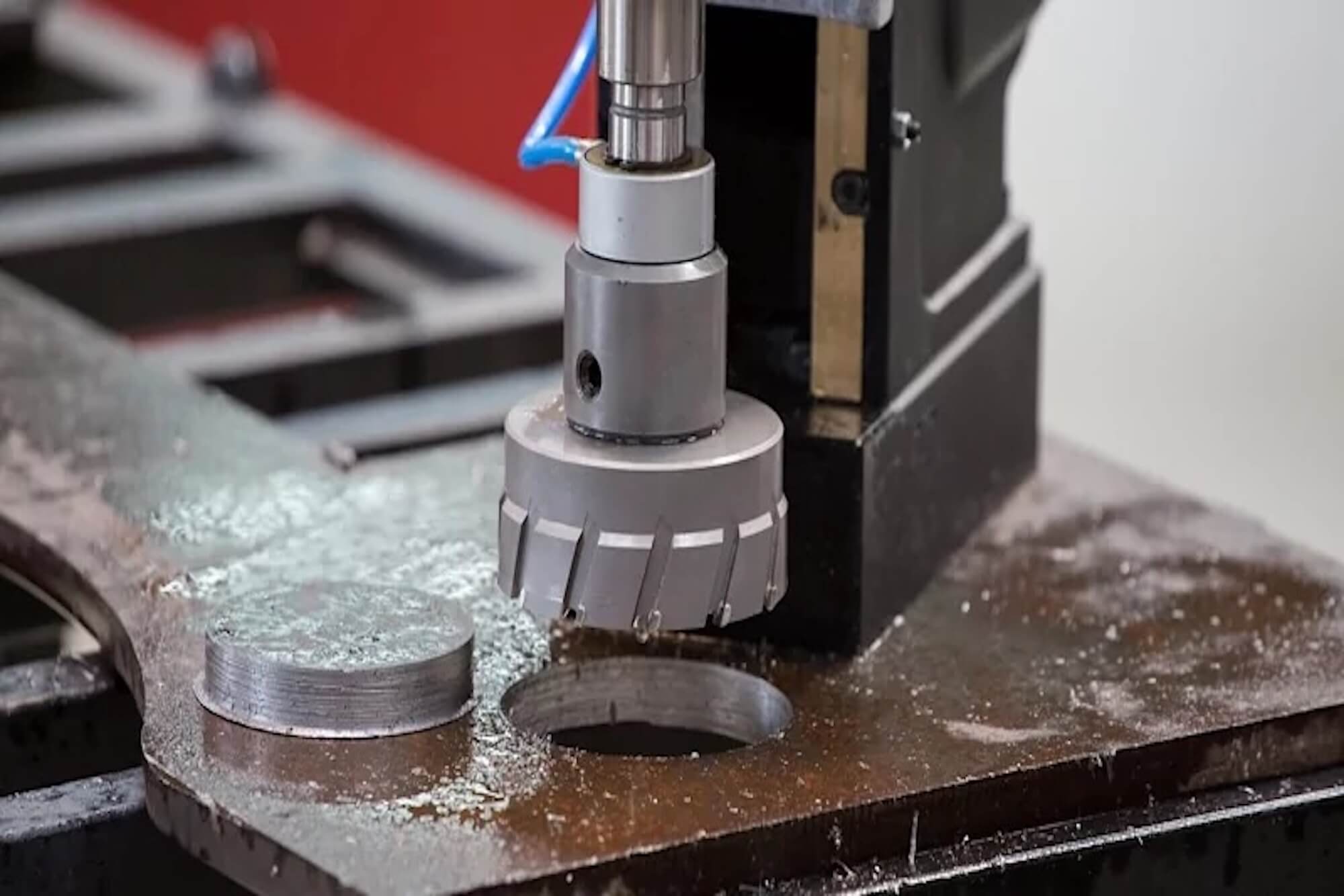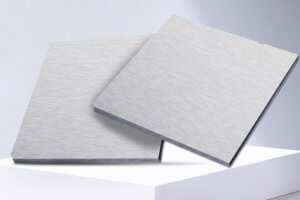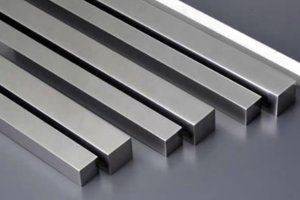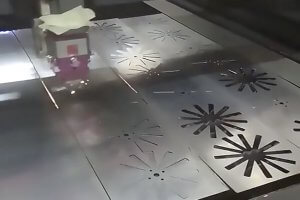I. Introduction
Metal rivets have been around for centuries. Even in today’s high-tech, precision-engineered world, they’re still everywhere. From aircraft skins to laptop chassis, metal rivets provide a reliable, permanent way to connect parts—especially in environments where vibration or dynamic loads are involved.
I work mostly with CNC-machined parts. Over time, I’ve realized that understanding how to integrate rivets into machined components can save enormous amounts of time and rework during final assembly. It’s not just about making holes—it’s about understanding how those holes will be used in the assembly line.
In this article, I’ll walk through what it really means to prepare CNC parts for metal rivet assembly. We’ll talk about rivet types, hole design, alignment strategies, and real-world mistakes that I’ve learned to avoid. If you’re designing or machining parts that will be riveted later, this guide is for you.
This is not a generic how-to. It’s a practical, field-tested look at how metal rivets and CNC machining work together in the real world—and how to do it right from the start.
II. Common Types of Metal Rivets and Their Structural Requirements
There are many types of metal rivets. Each type is designed for specific loads, materials, and assembly methods. When designing CNC parts for rivets, the type of rivet matters just as much as the placement of the holes.
Here’s a breakdown of the most common types of rivets used in CNC-related applications:
| Rivet Type | Description | Installation Method | Reusability | Common Materials | Strength Rating |
|---|---|---|---|---|---|
| Solid Rivets | One-piece rivets hammered into place | Requires access both sides | No | Aluminum, Steel, Titanium | Very High |
| Blind Rivets | Installed from one side using mandrel | One-sided installation | No | Aluminum, Stainless Steel | Moderate |
| Semi-Tubular Rivets | Hollow shank, lighter setting force | Press-fit or impact tool | No | Brass, Copper, Aluminum | Low-Medium |
| Self-Piercing Rivets | No pre-drill required | Punch-press | No | Steel, Aluminum | High |
| Flush (Countersunk) Rivets | Sits below surface | Hammered or squeezed | No | Aluminum, Steel | High |
| Drive Rivets | Hammered with no access to opposite side | Hammer set | No | Aluminum, Nylon | Low-Medium |
| Split Rivets | Expands inside hole with split tail | Manual | No | Soft metals | Low |
Matching Rivet Type with CNC Parts
From experience, solid and blind rivets are the most CNC-compatible. Solid rivets require precise alignment, which CNC machining can provide. Blind rivets, being installed from one side, are ideal for enclosures or assemblies that don’t allow internal access.
Materials Matter
If you’re working with aluminum CNC parts, choose rivets with similar material characteristics. This prevents galvanic corrosion, a common issue when dissimilar metals interact over time.
Load-Bearing Considerations
Metal rivets are often used in structural assemblies. In that case, choose solid or self-piercing rivets over decorative or split styles. This impacts how CNC parts are designed—especially when it comes to part thickness, hole diameter, and load transfer geometry.
Hole Design Must Match Rivet Type
Each rivet has a recommended hole size, based on the shank diameter and grip range. A poorly sized hole leads to weak joints, loose fit, or even failure during installation. I once machined an entire batch of CNC aluminum plates with holes 0.1mm too large. The blind rivets spun instead of setting properly—lesson learned.
Here’s a sample chart I now keep handy during part design:
| Rivet Size (inches) | Hole Diameter Range (inches) | Typical Grip Range | Head Type | Applications |
|---|---|---|---|---|
| 1/8″ (3.2 mm) | 0.128″–0.132″ | 0.02–0.08″ | Dome / Countersunk | Light panels, brackets |
| 5/32″ (4.0 mm) | 0.160″–0.164″ | 0.06–0.12″ | Dome / Flat | General hardware assembly |
| 3/16″ (4.8 mm) | 0.193″–0.199″ | 0.10–0.20″ | Dome / Large flange | Automotive, structural |
| 1/4″ (6.4 mm) | 0.260″–0.265″ | 0.18–0.30″ | Dome / Countersunk | High-load brackets, beams |
Summary Tips:
- Match rivet material with base material to avoid corrosion.
- Always confirm hole tolerance against rivet spec sheets.
- Avoid overly soft or thin sections near rivet holes.
- Keep standard diameters unless there’s a compelling reason to go custom.
III. Integrating Rivet Assembly into CNC Part Design
One of the most important things I learned early on is that if you don’t design with rivets in mind, your CNC-machined parts won’t work well in final assembly. Rivet integration isn’t just about drilling holes—it’s about how the part is intended to be joined from day one.
Here’s how I approach rivet-friendly design in every CNC part I make.
🔩 Hole Diameter and Fit Tolerances
The fit between the rivet and the hole matters more than people think. Too tight, and you risk deforming or cracking the part. Too loose, and the rivet may spin or fall out before it’s set.
A basic guideline I follow:
| Rivet Shank Diameter | Recommended Hole Size (mm) | Tolerance (mm) | Fit Type |
|---|---|---|---|
| 3.2 mm (1/8″) | 3.3 – 3.4 mm | +0.1 / +0.2 mm | Loose/Slip Fit |
| 4.0 mm (5/32″) | 4.1 – 4.2 mm | +0.1 / +0.2 mm | Slip Fit |
| 4.8 mm (3/16″) | 4.9 – 5.0 mm | +0.1 / +0.2 mm | Loose Fit |
| 6.4 mm (1/4″) | 6.5 – 6.6 mm | +0.1 / +0.2 mm | Loose Fit |
I usually add a bit of chamfer around the top edge to help guide the rivet during assembly.
🌀 Countersinks and Dimples
Flush rivets are often used in aerospace or consumer electronics where smooth surfaces matter. For that, you need precision countersinks.
- Standard countersink angle: 100° (aviation), 90° or 120° (industrial)
- Depth should match head profile without cutting past material thickness
You can also use dimples (dimple die forms) for thin sheet parts. I’ve seen them a lot in lightweight aluminum brackets, and CNC can cut pilot dimples to guide secondary forming.
📏 Spacing and Edge Distance
Poor spacing causes cracks and weak joints. My rule of thumb:
- Hole spacing: 3×D (3 times the rivet diameter) minimum
- Edge distance: 2×D minimum from center to part edge
For example, if you’re using a 5/32” (4.0 mm) rivet:
- Spacing: ≥12 mm
- Edge distance: ≥8 mm
📐 CAD Modeling Rivets
I used to leave rivets out of my CAD models, but that caused problems during reviews and DFM checks. Now I:
- Add rivet placeholders as construction geometry
- Tag them with part numbers and hole callouts
- Use hole wizard features in SolidWorks or hole presets in Fusion 360
This helps clarify intent, and it’s easier to communicate with suppliers or downstream teams.
🎯 Functional Design Tips
- If the part sees vibration or cyclic load, go with solid or self-piercing rivets.
- For plastic or soft material CNC parts, avoid over-concentrating rivets in one region.
- For blind rivets, always verify you’ll have access from one side only.
IV. CNC Machining Best Practices for Rivet-Ready Parts
Once you’ve designed the part to accept metal rivets, it’s time to machine it properly. The most common issue I see in shops is hole inaccuracy—especially when you have multiple parts to align. Here’s how I avoid that.
🧰 Tooling for Rivet Hole Machining
To get precision holes for rivets, here’s what I usually use:
| Operation | Tool Type | Purpose |
|---|---|---|
| Pilot Hole | Twist Drill (High-speed) | Initial hole before reaming |
| Final Sizing | Reamer | Tight diameter control |
| Countersink | 90°, 100°, or 120° tool | For flush rivet heads |
| Chamfering | Single-flute chamfer mill | Break sharp edges |
| Spot Drill | Centering holes | Prevent walking during drill |
Pro tip: Always use a spot drill first if you’re going for precision. It keeps the twist drill centered and avoids oval holes.
⚙️ Feeds and Speeds for Rivet Holes
Here’s a sample of typical speeds and feeds I use for aluminum parts:
| Tool | Material | Spindle Speed (RPM) | Feed Rate (mm/min) | Notes |
|---|---|---|---|---|
| 3.3 mm Drill Bit | Aluminum | 4500 | 250 | For 1/8″ rivets |
| 5 mm Reamer | Aluminum | 2000 | 150 | Smooth final sizing |
| 90° Countersink | Aluminum | 3500 | 100 | For flush rivet heads |
| Spot Drill (120°) | Aluminum | 3000 | 80 | Prevent drill walk |
| Chamfer Tool | Aluminum | 3000 | 120 | Break sharp hole edges |
Of course, always adjust for your machine’s rigidity and coolant setup.
🧩 Hole Alignment and Concentricity
If your parts are meant to be stacked and riveted, hole-to-hole alignment is critical. I’ve had assemblies fail just because holes were off by 0.2 mm.
I use:
- Dowels or alignment pins in the fixture
- Dual-sided CNC setups to avoid flipping errors
- G-code subroutines to mirror hole positions across identical parts
Batch consistency matters most when you’re doing 50+ parts. One misaligned hole ruins the entire stack.
🔧 Workholding and Setup Tips
For precise CNC hole work:
- Use vacuum fixtures or multi-part plates to process parts in batches.
- Always probe for Z-height before countersinking.
- Leave rivet holes as the final machining operation to reduce distortion.
In my experience, rushing the hole process always backfires. A rivet-ready part is only as good as the holes that hold it together.
V. Material Considerations: How Different Metals Affect Riveting
When using metal rivets with CNC-machined parts, the choice of material significantly affects the success of the assembly. I’ve made the mistake of assuming aluminum parts always behave the same way—until a few cracked under rivet load, or worse, deformed during installation.
Here’s what I’ve learned about materials and how they respond to riveting.
🔍 Base Material vs. Rivet Material
Always try to match or closely align the mechanical properties of the rivet and base material. Dissimilar materials may cause:
- Galvanic corrosion: e.g., steel rivets in aluminum parts
- Deformation: softer materials like copper or thin aluminum sheets
- Improper grip: if hardness varies too much, the rivet may not set
🔩 Material Comparison Table
| CNC Material | Common Rivet Match | Rivet Notes | Risk Factors | Recommendations |
|---|---|---|---|---|
| Aluminum (6061/7075) | Aluminum or Steel | Excellent compatibility | Avoid overcompression | Pre-drill & deburr |
| Stainless Steel | Stainless Rivets | Strong joints, corrosion resistant | Hard to drill, may work-harden | Use coated drill bits |
| Mild Steel | Steel or Zinc Rivets | Budget-friendly, durable | Prone to rust without coating | Consider passivation or paint |
| Brass or Copper | Brass, Copper Rivets | Good formability, decorative joints | Soft, easy to deform | Use light-pressure setting tools |
| Plastic (ABS/PC) | Aluminum/Blind Rivets | May crack if overtightened | Not heat-resistant | Use low-grip blind rivets |
| Titanium | Titanium Rivets | Lightweight, very strong | Expensive, hard to machine | Only for high-performance use |
🧱 Wall Thickness and Rivet Grip Range
Another critical consideration is material thickness. Every metal rivet has a grip range—the total thickness it can reliably fasten.
For instance:
- A 1/8″ (3.2 mm) blind rivet might support a 0.5–4.0 mm grip range.
- A solid rivet often needs at least 1.5 mm per part side to form a proper head.
If the CNC-machined part is too thin:
- Rivet heads may pull through
- The part may deform or dent
- You may need to add washers, spacers, or backing plates
When I worked on an aluminum enclosure project, I didn’t factor in the thickness of the internal bracket. The result? The rivets bottomed out before forming properly. Since then, I always check total thickness vs grip range in CAD.
🌡️ Heat & Expansion
Materials like aluminum and stainless steel expand differently under heat. If your parts will be used outdoors or near motors, differential expansion could stress riveted joints. I now:
- Avoid tight tolerance stacking with mixed materials
- Use slightly oversized holes in expansion-critical areas
- Choose flexible joints where needed (e.g., floating bushings)
🧠 Design Tips:
- Check grip range of rivets before ordering parts
- Add backing features to strengthen thin areas
- Match rivet and part material when possible
- Avoid designs that place heavy stress on a single rivet point
VI. Assembly Process: From Machined Part to Riveted Structure
Once you’ve machined the parts and selected the right rivets, the final step is bringing it all together—accurately and efficiently.
I’ve seen both clean, professional rivet assemblies… and some absolute disasters. Good assembly starts with preparation.
🔧 Step 1: Cleaning and Deburring
Always remove burrs and chips from rivet holes. Even a small burr can misalign a rivet or prevent full seating.
- I use a 0.2 mm chamfer or manual deburring tool
- Clean holes with compressed air and isopropyl alcohol before assembly
🧰 Step 2: Rivet Selection and Tools
Here’s a quick reference of the tools I use and when:
| Rivet Type | Tool Needed | Best For | Notes |
|---|---|---|---|
| Solid Rivets | Pneumatic or manual hammer | Structural parts | Requires access to both sides |
| Blind Rivets | Hand riveter or pneumatic gun | One-side assembly | Fast and easy to install |
| Semi-tubular | Press or squeezer tool | Decorative or light-duty uses | Needs backing plate support |
| Self-Piercing | Hydraulic press | Automotive, structural sheet parts | Requires expensive tooling |
🧩 Step 3: Assembly Alignment
Use alignment pins or fixtures to hold CNC parts together while riveting. In tight-tolerance applications, I always use:
- Laser-cut alignment jigs
- 3D-printed drill guides
- Dowels to center stack-ups
For parts with >5 rivets, I temporarily install one or two with removable clecos before setting the rest.
🔨 Step 4: Riveting
Apply consistent pressure. Uneven or rushed riveting often causes part bending or rivet tilt.
If you’re setting more than 20 rivets, I recommend pneumatic tools. They’re faster and give a uniform set.
Visual signs of a good rivet:
- Head is flush with surface (or slightly recessed for countersinks)
- Tail is mushroomed evenly or properly collapsed (blind rivets)
- No cracks in surrounding material
🧪 Step 5: Inspection and Testing
I always run a visual inspection first:
- Check rivet spacing and symmetry
- Ensure heads are seated flat and not tilted
- Look for part deformation, cracks, or bulging
For structural applications, you can run shear or pull tests using basic jigs.
If a rivet is poorly seated:
- Drill it out using a slightly smaller drill bit than the shank
- Carefully deburr and insert a new rivet
VII. Case Studies & Application Scenarios
To understand how metal rivets and CNC machining complement each other, I’ve pulled together a few real-world examples from my projects and from industries where these techniques are critical.
Each scenario highlights different challenges and how CNC precision plays a role in effective rivet integration.
✈️ Case Study 1: Aircraft Panel Assembly with Flush Rivets
Industry: Aerospace
Material: 7075 Aluminum
Rivet Type: Solid, countersunk rivets
CNC Role: Hole drilling + countersinking
I once worked on a subcontracted aerospace part: an access panel made from 7075 aluminum sheets, designed to be flush with the fuselage. Rivet heads couldn’t protrude, which meant the countersink angles and hole depths had to be perfect.
We used CNC milling to:
- Drill precision-aligned holes (±0.05 mm)
- Countersink to a 100° angle
- Spot drill pilot points to avoid walk
Flush rivets installed cleanly. No sanding was needed post-assembly, which was a big win in both time and aesthetics.
🚗 Case Study 2: Automotive Bracket Riveting
Industry: Automotive (Tier 2 Supplier)
Material: Mild steel (CNC bent brackets)
Rivet Type: Blind rivets
CNC Role: Hole drilling
In this case, the part was a brake-line mounting bracket. The challenge was repeatable accuracy for a part being made in batches of 500+ units.
We created a jig with a multi-part CNC bed that let us drill 8 brackets at a time. Once drilled:
- Brackets were deburred automatically in a tumbler
- Blind rivets were inserted with pneumatic guns
CNC ensured identical hole spacing and positioning, which meant perfect fits on the line.
💻 Case Study 3: Consumer Electronics Enclosure
Industry: Electronics
Material: Anodized aluminum + internal ABS bracket
Rivet Type: 1/8″ dome-head blind rivets
CNC Role: Housing drilling + countersinking + dimple registration
This project involved assembling small metal casings for a handheld device. A major issue was plastic deformation when rivets were installed too close to the edge of thin aluminum walls.
We redesigned the housing in CAD to:
- Push rivet holes further inward
- Add CNC-machined dimples to help guide the drill
- Reduce wall thickness variation
The final product felt solid, and users never saw the rivet heads because of countersinking. CNC helped eliminate cosmetic defects and post-processing.
🛠️ General Application Summary
| Application Type | CNC Role | Recommended Rivet Type | Key Consideration |
|---|---|---|---|
| Aerospace panels | Precision drilling + countersink | Solid, flush | Uniform depth & angle |
| Automotive brackets | Batch drilling | Blind rivets | Batch jigging & spacing |
| Electronics enclosures | Housing + bracket hole prep | Dome blind / flush blind | Cosmetic finish, thin-wall control |
| HVAC ducting | Flat sheet hole drilling | Self-piercing | Speed and one-side access |
| Furniture hardware | Manual drilling + CNC guides | Semi-tubular | Low-cost and visual appeal |
VIII. Common Challenges and How to Solve Them
Over time, I’ve seen the same problems happen repeatedly when CNC-machined parts are joined with metal rivets. Here’s a roundup of those common issues—and how to solve (or prevent) them.
❌ Problem 1: Misaligned Holes in Multi-Part Assemblies
Cause: Poor hole matching, inconsistent part orientation in setup
Fix:
- Use dowel pins or laser alignment jigs
- Add reference holes in non-critical areas for pilot setup
- Machine all mating parts in the same fixture if possible
❌ Problem 2: Rivet Heads Not Seating Properly
Cause: Inconsistent countersink depth or burrs
Fix:
- Use probe touch-off to get consistent Z height
- Apply chamfer or deburring after drilling
- Spot drill before twist drilling for clean entry
❌ Problem 3: Deformed Thin Sections Near Rivets
Cause: Material too thin or unsupported during setting
Fix:
- Use washers or internal back plates
- Increase part thickness or add local bosses
- Use lower-pressure riveting tools for soft materials
❌ Problem 4: Spinning or Loose Rivets
Cause: Hole too large or grip range mismatch
Fix:
- Match hole diameter to rivet spec (+0.1 mm max)
- Always check total material thickness vs grip range
- Choose a larger rivet size if necessary
❌ Problem 5: Cosmetic Surface Damage
Cause: Poor tool control, over-squeezing, or no countersink
Fix:
- Use flat anvils on rivet guns to avoid tool marks
- Program chamfer depth carefully
- Avoid installing rivets too close to curves or edges
🧠 Quick Reference: Troubleshooting Table
| Issue | Likely Cause | Recommended Fix |
|---|---|---|
| Rivet spinning | Hole too loose | Tighter tolerance, ream before insert |
| Head not flush | Shallow countersink | Adjust toolpath or verify angle |
| Cracked material | Hole too close to edge | Move hole inward, add backing |
| Rivet doesn’t set fully | Grip range too small | Use correct rivet size |
| Part misalignment | Fixture slippage | Pin registration or better clamping |
IX. Designing for Maintenance and Repair
Most people think of metal rivets as permanent. And that’s usually true—especially in aerospace or automotive contexts. But in my experience, some CNC assemblies do need to be taken apart or serviced after final assembly. That’s when smart design can make all the difference.
🔄 Serviceability vs Permanence
Ask yourself upfront:
- Will this assembly ever need to be opened?
- Is it more cost-effective to make it repairable?
- Can a technician replace this in the field?
If the answer is yes to any of these, your rivet strategy needs to shift.
🪛 Design Tips for Easier Repair
- Use removable rivets in non-critical areas
→ Use blind rivets with drill-out-friendly heads or softer material - Incorporate drill guides or pilot points
→ Helps ensure that repair teams remove rivets without damaging CNC parts - Avoid stacking rivets over electronic boards or fragile parts
→ If rivet must go there, design access holes behind it - Combine rivets with threaded inserts or screws in key locations
→ I’ve used this hybrid method on enclosures with both fixed and serviceable zones - Clearly label rivets for removal (laser-etched IDs)
→ Especially helpful in high-mix production environments
🧰 Repair and Replacement Tools
Here’s a quick breakdown of tools and methods I’ve used for rivet repair:
| Task | Tool | Notes |
|---|---|---|
| Rivet removal | Hand drill + center punch | Drill slightly smaller than shank |
| Hole cleanup | Deburring tool / countersink | Smooth edge after removal |
| Rivet replacement | Same size rivet or next size | Never reuse old holes if oversized |
| Upgrade to screw | Thread insert (e.g., Helicoil) | Requires tapping or CNC rework |
⚠️ When Not to Use Rivets
There are cases where rivets make repair harder than needed. If your CNC parts will be:
- Repeatedly serviced
- Modified frequently
- Subjected to tight tolerance changes
…then you may want to avoid metal rivets altogether and go with threaded fasteners.
X. Conclusion
Over the years, I’ve come to see metal rivets as more than just “old school” fasteners. When paired with CNC machining, they become a precision-compatible, cost-effective, and structurally sound method of assembly—especially in projects where consistency and vibration resistance matter.
Good design isn’t about perfection; it’s about intentional tradeoffs. Metal rivets give you that control, but only when paired with thoughtful part modeling, clean CNC machining, and an understanding of how everything will come together.
When I design CNC parts now, I ask:
- Where should this be permanent?
- Where should it be removable?
- What’s the cleanest way to achieve both?
With the right mix of rivets, holes, chamfers, and material choices, CNC assemblies can be beautiful, durable, and repeatable. That’s what makes this workflow so rewarding—and what I hope you take from this guide.
FAQ
- What’s the best hole tolerance for installing metal rivets in CNC parts?
Typically +0.1 to +0.2 mm over rivet shank diameter for a slip fit. - Can CNC machines make countersinks for flush rivets?
Yes. Use a 90°, 100°, or 120° countersink tool and carefully control Z-depth. - How do I prevent misaligned holes in stacked CNC parts?
Use dowel pins, mirrored toolpaths, and multi-part jigs for alignment. - What’s the best rivet for one-sided CNC assembly?
Blind rivets—they can be installed from one side with a rivet gun. - Do I need to deburr rivet holes after CNC drilling?
Yes. Even small burrs can affect rivet fit and head seating. - How do I choose between a rivet and a screw for CNC parts?
Use rivets for permanent, vibration-resistant joints; screws for removable or adjustable ones. - Can metal rivets be used in plastic CNC parts?
Yes, but use low-pressure blind rivets and avoid over-torquing. - What’s the ideal spacing between rivets in a CNC bracket?
Minimum 3×D spacing between holes; 2×D edge distance from part edge. - How do I remove a faulty rivet from a CNC-machined part?
Drill out the head with a smaller bit than the shank, then punch it through. - What is grip range and why does it matter?
It’s the total thickness a rivet can secure. Always match it to your material stack-up. - Should I use solid or blind rivets in aluminum parts?
Depends on access. Solid rivets are stronger, but require access from both sides. - Can CNC parts support self-piercing rivets?
Usually no—self-piercing rivets require press systems and aren’t used on thick machined stock. - What are the risks of mixing rivet and part materials?
Dissimilar metals can cause galvanic corrosion. Match aluminum with aluminum where possible. - What tools are best for high-volume rivet assembly in CNC parts?
Pneumatic rivet guns or hydraulic press setups for consistency and speed. - How do I avoid cosmetic damage when riveting CNC parts?
Use flat anvils, smooth countersinks, and avoid over-setting rivets. - Are there CAD libraries for rivet modeling?
Yes. GrabCAD, McMaster-Carr, and SolidWorks Toolbox all offer rivet models. - What’s the best way to mix rivets and screws in a single design?
Use rivets for fixed joints and screws in serviceable zones; clearly separate zones in CAD.
References & Further Reading
For readers interested in exploring the technical, historical, and engineering foundations of metal rivets and CNC machining, here are several reliable, knowledge-based resources:
- Rivet – Wikipedia
A comprehensive overview of rivet types, history, mechanical principles, and applications in modern manufacturing.
👉 https://en.wikipedia.org/wiki/Rivet - Injection Moulding – Wikipedia
Includes insights into how CNC-machined molds are used in high-volume manufacturing, particularly in automotive and industrial applications.
👉 https://en.wikipedia.org/wiki/Injection_moulding - Numerical Control (CNC) – Wikipedia
A well-structured explanation of CNC technology, its evolution, and how it is used across different manufacturing sectors.
👉 https://en.wikipedia.org/wiki/Numerical_control - Advancements in CNC Machining for Tooling
A peer-reviewed article exploring how CNC machining is used in the design and production of molds and metal components.
👉 https://www.sciencedirect.com/science/article/pii/S2772369021000074
Other Articles You Might Enjoy
- Plastic Rivets Prototyping and Production machining: A Modern Solution for Complex Fasteners
Understanding Plastic Rivets: Types, Uses, and Materials Plastic rivets are versatile fasteners used to join materials in various applications. Unlike metal rivets, plastic rivets are lightweight, corrosion-resistant, and non-conductive, making…
- Riveting Quality Starts with Precision: Why CNC Machining Matters
Introduction Riveting is one of those processes people often take for granted. I’ve seen it used in aircraft panels, metal furniture, elevator enclosures, HVAC ducting, and even on high-end kitchen…
- Custom Rivet Nut Manufacturing: Materials, Design & CNC Machining Explained
Chapter 1: Overview of Rivet Nuts I remember the first time I encountered a rivet nut. I was puzzled by its appearance and curious about how something so small could…
- Types of Rivets: A Comprehensive Guide
Introduction: The Critical Role of Rivets in Multiple Industries Rivets are permanent mechanical fasteners that are critical in the assembly of everything from simple structures to complex machinery across numerous…
- Nuts and Bolts Machining Explained: Methods, Standards, and CNC Tips
Introduction: Why Nuts and Bolts Are More Complex Than They Look If you’ve ever walked into a machine shop or looked at a mechanical assembly, you’ve probably noticed one thing…
- Stainless Steel Fasteners: What Designers and CNC Machinists Must Know
Why Stainless Steel Fasteners Matter in CNC Applications As someone who has spent significant time around CNC machines and designing mechanical assemblies, I've learned one critical truth: the smallest parts…
- Automotive Fasteners Manufacturing Guide: Precision, Strength & Industry Standards
I’ve spent a good part of my career exploring how Automotive Fasteners shape a vehicle’s overall safety and performance. I’ve personally toured manufacturing facilities, spoken with CNC operators, and tested…
- Machining Techniques for Parts: Unlocking CNC and Cutting-Edge Tech
I. Introduction I remember the first time I realized how critical machining is to modern manufacturing. I was interning at a small shop, watching a CNC machine carve intricate features…






